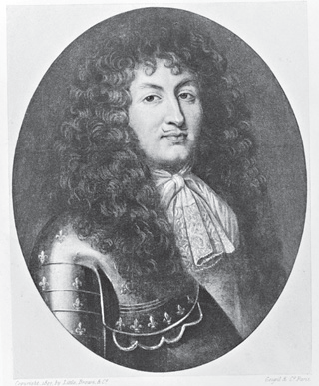He was nicknamed the Sun King because, in seventeenth-century France, everything was said to revolve around King Louis XIV (1638–1715). The prototype of the absolute monarch, Louis occupied the throne of France for seventy-two years, a record unsurpassed in Europe before or since, and consolidated the power of the French state almost entirely in his hands.

The king’s attitude toward his role in government was summed up in his famous motto, L’état, c’est moi—“I am the state.”
Louis, the oldest son of King Louis XIII (1601–1643), inherited the crown when he was only five years old. During the first eight years of his reign, his mother, Queen Anne (1601–1666), ruled in his place as regent. When he turned twenty-three, Louis took full control of the kingdom.
As king, Louis reduced the power of both the French nobility and the government ministers. Whereas his parents had delegated the day-to-day responsibilities of governing France to an aide, Cardinal Mazarin (1602–1661), Louis assumed full personal control over the government after Mazarin’s death. He built the famous Palace of Versailles, just outside Paris, as a monument to both the growing international power of France and its increasingly centralized government under the king.
Louis fought and won several European wars, defeating the Netherlands and its allies in 1678 and seizing Alsace from the Holy Roman Empire in 1684. The outcome of the wars made France the strongest military power in Europe, although the nation was dealt a setback in the War of the Spanish Succession (1701–1714), which prevented France from uniting with Spain to form a continental superpower.
The Sun King’s reign was also a period of artistic and cultural flowering in France. In addition to building Versailles, Louis improved the Louvre Museum and built a massive military complex in Paris, the Hôtel des Invalides, for retired soldiers. By the time Louis died at age seventy-seven, he had outlived both his son and his grandson; he was succeeded on the throne by his great-grandson, Louis XV (1710–1774).
ADDITIONAL FACTS
- Louis revoked the Edict of Nantes, which had granted Protestants freedom to worship in France, in 1685. French Jews and Protestants were not accorded full citizenship until the French Revolution in 1789.
- Louis married a Spanish princess, María Theresa (1638–1683), in 1660. They had three children. After the queen’s death, he secretly married his longtime mistress, Françoise d’Aubigné Scarron (1635–1719).
- The state of Louisiana, which was founded as a French colony in 1682, was named after the king.
